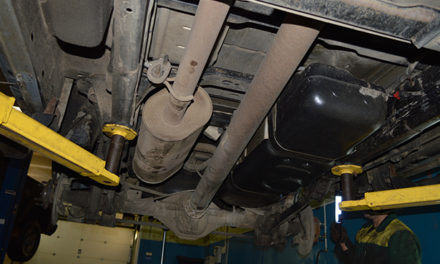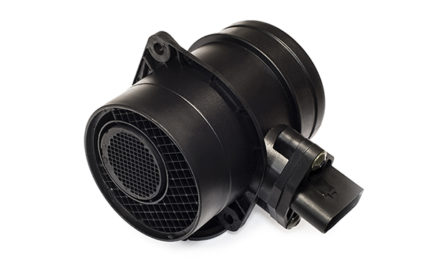In part 1, the article discussed sensors that use information forwarded to the PCM/ECM by other sensors to make adjustments to the air-to-fuel ratio the engine requires to run efficiently. Part 2 discusses the sensors that feed the information to the computer.
Sensors That Feed InformationThe sensors that feed information measure things such as water temperature, air temperature, barometric pressure and the amount of oxygen in the exhaust. These include the water temperature sensor, mass air flow (MAF) sensor, throttle position sensor, the intake manifold pressure sensor (MAP), crankshaft sensor and oxygen sensor.
- Water Temperature Sensor: Often referred to as the coolant temperature sensor, the water temperature sensor tells the control module what temperature the engine is running by measuring the temperature of the antifreeze. If the engine is cold, the vehicle needs more fuel to run properly. The coolant temperature sensor tells the computer to richen the mixture – add more fuel to the mixture. This sensor has another job – in many vehicles, it turns the electric fan on to cool the radiator and engine.
- MAF Sensor: The MAF sensor tells the control module how much air enters the engine as you are driving. The control module varies the amount of fuel based on the amount of air in the engine to keep the fuel to air ratio at the proper mixture for the best fuel mileage and emissions. It also measures the density of the air, e.g., how much water (humidity) is in the air and adjusts the fuel accordingly.
- Throttle Position Sensor: This sensor tells the control module where the throttle is. Does the driver have his or her foot all the way in or at just above an idle? The parameters forwarded by the TPS tell the computer to change the spark timing and the fuel mixture based on what the driver is requesting.
- MAP Sensor: The MAP sensor measures how much vacuum is in the engine and sends the signal to the control module, which in turn used this parameter to determine how much load is on the engine. While this sensor’s main function is to tell the computer how to adjust the timing, it does affect fuel delivery. If the engine is idling, the control module changes the timing and the fuel ratio. As you give the vehicle more gas, the control module richens the fuel mixture for the power that the driver is requesting.
- Crankshaft Position Sensor: These sensors tell the computer what RPM the engine is running at and the position of the crankshaft. Using this information, the computer can then adjust fuel delivery and spark timing to make sure the spark from the ignition ignites the fuel in the cylinder at the proper time. Most vehicles use the crankshaft position sensor in conjunction with the camshaft position sensor, which measures valve timing. Some vehicles have a combination crankshaft/camshaft position sensor.
- Oxygen Sensor: The oxygen sensor tells the control module how much-unburned fuel is in the exhaust. The control module uses the parameters sent by one or more oxygen sensors to adjust the air-to-fuel ratio, keeping fuel consumption and emissions as low as possible. If an oxygen sensor is bad, it could cause the engine to run rich – burn more fuel than is actually required.
Without these sensors, electronic fuel injection would not work. Because there are so many parameters required to make the engine run in an efficient manner, there are many sensors. Before you blame something mechanical for your problems, have your vehicle scanned for potential problems with the sensors or computer, even if the engine light is not on. If the computer malfunctions, it cannot diagnose itself and may not turn the warning light on. If the bulb in the light has burned out, you could be replacing a fuel pump when you should be replacing a sensor.







![[Vehicle Fitment]: Compatible with Buick Regal 2014-2017 L4 2.0L; Compatible with Cadillac ATS 2013-2017 L4 2.0L, CTS 2014-2016 L4 2.0L; Compatible with Chevrolet Camaro 2016-2017 L4 2.0L, Malibu 2013-2017 L4 2.0L---Turbocharged Only [Reference Numbe...](https://m.media-amazon.com/images/I/410W0fH2PfL._SL100_.jpg)
![[Vehicle Fitment-1]: Compatible with Chevrolet Silverado 1500 2000-2006 4.8L/5.3L, Silverado 1500 2003-2007 6.0L, Silverado 1500 Classic 2007 4.8L/5.3L, Silverado 1500 HD 2001-2003 6.0L, Silverado 1500 HD 2005-2006 6.0L, Silverado 1500 HD Classic 200...](https://m.media-amazon.com/images/I/51BqchUM7gL._SL100_.jpg)

![❣[IMPORTANT NOTE] Please check with the fitment chart or OEM number for the right compatibility before purchase. ❣[FITMENT] Compatible with 2001 2002 Acura CL V6-3.2L 丨 1999 2000 2001 Acura TL V6-3.2L 丨 1998 1999 2000 2001 2002 Honda Accord L4-2.3L 丨...](https://m.media-amazon.com/images/I/31fdEk+nQGL._SL100_.jpg)

Full covers the fuel pressure and sensor may just be the root of my dilemma